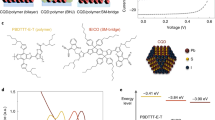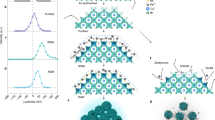Abstract
Colloidal quantum dot (CQD) films allow large-area solution processing and bandgap tuning through the quantum size effect1,2,3,4,5,6. However, the high ratio of surface area to volume makes CQD films prone to high trap state densities if surfaces are imperfectly passivated, promoting recombination of charge carriers that is detrimental to device performance7. Recent advances have replaced the long insulating ligands that enable colloidal stability following synthesis with shorter organic linkers or halide anions8,9,10,11,12, leading to improved passivation and higher packing densities. Although this substitution has been performed using solid-state ligand exchange, a solution-based approach is preferable because it enables increased control over the balance of charges on the surface of the quantum dot, which is essential for eliminating midgap trap states13,14. Furthermore, the solution-based approach leverages recent progress in metal:chalcogen chemistry in the liquid phase15,16,17,18,19. Here, we quantify the density of midgap trap states20,21,22 in CQD solids and show that the performance of CQD-based photovoltaics is now limited by electron–hole recombination due to these states. Next, using density functional theory and optoelectronic device modelling, we show that to improve this performance it is essential to bind a suitable ligand to each potential trap site on the surface of the quantum dot. We then develop a robust hybrid passivation scheme that involves introducing halide anions during the end stages of the synthesis process, which can passivate trap sites that are inaccessible to much larger organic ligands. An organic crosslinking strategy is then used to form the film. Finally, we use our hybrid passivated CQD solid to fabricate a solar cell with a certified efficiency of 7.0%, which is a record for a CQD photovoltaic device.
This is a preview of subscription content, access via your institution
Access options
Subscribe to this journal
Receive 12 print issues and online access
$259.00 per year
only $21.58 per issue
Buy this article
- Purchase on Springer Link
- Instant access to full article PDF
Prices may be subject to local taxes which are calculated during checkout




Similar content being viewed by others
References
Kramer, I. J. & Sargent, E. H. Colloidal quantum dot photovoltaics: a path forward. ACS Nano 5, 8506–8514 (2011).
Pattantyus-Abraham, A. G. et al. Depleted-heterojunction colloidal quantum dot solar cells. ACS Nano 4, 3374–3380 (2010).
Wang, X. et al. Tandem colloidal quantum dot solar cells employing a graded recombination layer. Nature Photon. 5, 480–484 (2011).
Semonin, O. E. et al. Peak external photocurrent quantum efficiency exceeding 100% via MEG in a quantum dot solar cell. Science 334, 1530–1533 (2011).
Kramer, I. J., Levina, L., Debnath, R., Zhitomirsky, D. & Sargent, E. H. Solar cells using quantum funnels. Nano Lett. 11, 3701–3706 (2011).
Schaller, R. & Klimov, V. High efficiency carrier multiplication in PbSe nanocrystals: implications for solar energy conversion. Phys. Rev. Lett. 92, 186601 (2004).
Gur, I., Fromer, N. A., Geier, M. L. & Alivisatos, A. P. Air-stable all-inorganic nanocrystal solar cells processed from solution. Science 310, 462–465 (2005).
Luther, J. M. et al. Structural, optical, and electrical properties of self-assembled films of PbSe nanocrystals treated with 1,2-ethanedithiol. ACS Nano 2, 271–280 (2008).
Law, M. et al. Structural, optical, and electrical properties of PbSe nanocrystal solids treated thermally or with simple amines. J. Am. Chem. Soc. 130, 5974–5985 (2008).
Koleilat, G. I. et al. Efficient, stable infrared photovoltaics based on solution-cast colloidal quantum dots. ACS Nano 2, 833–840 (2008).
Beard, M. C. et al. Variations in the quantum efficiency of multiple exciton generation for a series of chemically treated PbSe nanocrystal films. Nano Lett. 9, 836–845 (2009).
Tang, J. et al. Colloidal-quantum-dot photovoltaics using atomic-ligand passivation. Nature Mater. 10, 765–771 (2011).
Yu, M. et al. First principles study of CdSe quantum dots: stability, surface unsaturations, and experimental validation. Appl. Phys. Lett. 88, 231910 (2006).
Voznyy, O. Mobile surface traps in CdSe nanocrystals with carboxylic acid ligands. J. Phys. Chem. C 115, 15927–15932 (2011).
Owen, J. S., Park, J., Trudeau, P-E. & Alivisatos, A. P. Reaction chemistry and ligand exchange at cadmium-selenide nanocrystal surfaces. J. Am. Chem. Soc. 130, 12279–12281 (2008).
Mocatta, D. et al. Heavily doped semiconductor nanocrystal quantum dots. Science 332, 77–81 (2011).
Fu, H. et al. Impact of the growth conditions of colloidal PbS nanocrystals on photovoltaic device performance. Chem. Mater. 23, 1805–1810 (2011).
Nag, A. et al. Metal-free inorganic ligands for colloidal nanocrystals: S2−, HS−, Se2−, HSe−, Te2−, HTe−, TeS32, OH−, and NH2− as surface ligands. J. Am. Chem. Soc. 133, 10612–10620 (2011).
Tang, J. et al. Quantum dot photovoltaics in the extreme quantum confinement regime: the surface-chemical origins of exceptional air- and light-stability. ACS Nano 4, 869–878 (2010).
Galland, C. et al. Two types of luminescence blinking revealed by spectroelectrochemistry of single quantum dots. Nature 479, 203–207 (2011).
Liu, Y. et al. Dependence of carrier mobility on nanocrystal size and ligand length in PbSe nanocrystal solids. Nano Lett. 10, 1960–1969 (2010).
Nagpal, P. & Klimov, V. I. Role of mid-gap states in charge transport and photoconductivity in semiconductor nanocrystal films. Nature Commun. 2, 486 (2011).
Shuttle, C. G. et al. Experimental determination of the rate law for charge carrier decay in a polythiophene: fullerene solar cell. Appl. Phys. Lett. 92, 093311 (2008).
O'Regan, B. C., Scully, S., Mayer, A. C., Palomares, E. & Durrant, J. The effect of Al2O3 barrier layers in TiO2/dye/CuSCN photovoltaic cells explored by recombination and DOS characterization using transient photovoltage measurements. J. Phys. Chem. B 109, 4616–4623 (2005).
Liu, H. et al. Electron acceptor materials engineering in colloidal quantum dot solar cells. Adv. Mater. 23, 3832–3837 (2011).
Moreels, I. et al. Size-dependent optical properties of colloidal PbS quantum dots. ACS Nano 3, 3023–3030 (2009).
Ito, S. et al. Control of dark current in photoelectrochemical (TiO2/I−–I3−) and dye-sensitized solar cells. Chem. Commun. 4351–4353 (2005).
Huang, N. et al. Synergistic effects of ZnO compact layer and TiCl4 post-treatment for dye-sensitized solar cells. J. Power Sources 204, 257–264 (2012).
Yong, K-T., Sahoo, Y., Swihart, M. T. & Prasad, P. N. Shape control of CdS nanocrystals in one-pot synthesis. J. Phys. Chem. C 111, 2447–2458 (2007).
Heitsch, A. T., Patel, R. N., Goodfellow, B. W., Smilgies, D-M. & Korgel, B. A. GISAXS characterization of order in hexagonal monolayers of FePt nanocrystals. J. Phys. Chem. C 114, 14427–14432 (2010).
Jiang, Z., Lin, X-M., Sprung, M., Narayanan, S. & Wang, J. Capturing the crystalline phase of two-dimensional nanocrystal superlattices in action. Nano Lett. 10, 799–803 (2010).
Hanrath, T., Choi, J. J. & Smilgies, D-M. Structure/processing relationships of highly ordered lead salt nanocrystal superlattices. ACS Nano 3, 2975–2988 (2009).
Naka, S., Okada, H., Onnagawa, H. & Tsutsui, T. High electron mobility in bathophenanthroline. Appl. Phys. Lett. 76, 197–199 (2000).
Kalyuzhny, G. & Murray, R. W. Ligand effects on optical properties of CdSe nanocrystals. J. Phys. Chem. B 109, 7012–7021 (2005).
Hines, M. A. & Scholes, G. D. Colloidal PbS nanocrystals with size‐tunable near‐infrared emission: observation of post‐synthesis self‐narrowing of the particle size distribution. Adv. Mater. 15, 1844–1849 (2003).
Acknowledgements
This publication is based in part on work supported by an award (KUS-11-009-21) from the King Abdullah University of Science and Technology (KAUST), by the Ontario Research Fund Research Excellence Program and by the Natural Sciences and Engineering Research Council (NSERC) of Canada. The authors thank Angstrom Engineering and Innovative Technology for useful discussions regarding material deposition methods and control of the glovebox environment, respectively. The Advanced Light Source is supported by the Director, Office of Science, Office of Basic Energy Sciences, of the US Department of Energy (contract no. DE-AC02-05CH11231). The authors thank L. Goncharova, M. T. Greiner, E. Palmiano, R. Wolowiec and D. Kopilovic for their help during the course of the study. A.H.I. acknowledges support from the Queen Elizabeth II Graduate Scholarship in Science and Technology. D.Z. acknowledges support from the NSERC CGS D scholarship.
Author information
Authors and Affiliations
Contributions
A.H.I., S.M.T. and E.H.S. designed and directed this study and analysed the experimental results. A.H.I. and S.M.T. contributed to all the experimental work. S.H. and D.Z. carried out the photovoltage transient measurements. S.H. performed PLQE experiments. O.V. performed DFT, RBS and XPS analyses. D.Z. performed the optoelectronic simulations. R.D. assisted in conceptualization of the study and assisted in experimental work. L.L. synthesized the CQDs. L.R.R., K.W.C. and A.A. carried out the GISAXS measurements. G.H.C. performed the TOF measurements. A.F. performed XPS and CHN analyses. K.W.K. performed TAS and capacitance–voltage measurements. I.J.K. assisted with EQE measurements. Z.N. developed protocols for the separation of treatment constituents experiment and facilitated ICP AES measurements. A.J.L. assisted with device fabrication and testing. A.H.I., S.M.T. and E.H.S. wrote the manuscript. All authors commented on the paper.
Corresponding author
Ethics declarations
Competing interests
The authors declare no competing financial interests.
Supplementary information
Supplementary information
Supplementary information (PDF 2018 kb)
Supplementary information
Input files for DFT simulation with SIESTA (TXT 37 kb)
Rights and permissions
About this article
Cite this article
Ip, A., Thon, S., Hoogland, S. et al. Hybrid passivated colloidal quantum dot solids. Nature Nanotech 7, 577–582 (2012). https://doi.org/10.1038/nnano.2012.127
Received:
Accepted:
Published:
Issue Date:
DOI: https://doi.org/10.1038/nnano.2012.127
This article is cited by
-
Alkyl ammonium iodide-based ligand exchange strategy for high-efficiency organic-cation perovskite quantum dot solar cells
Nature Energy (2024)
-
Efficiency improvement in thin-film amorphous silicon solar cells based on PbS quantum dots
Indian Journal of Physics (2024)
-
Preparation and characterization of PbS nanoparticles by laser ablation technique
Journal of Optics (2024)
-
Performance optimization of efficient PbS quantum dots solar cells through numerical simulation
Scientific Reports (2023)
-
How to get high-efficiency lead chalcogenide quantum dot solar cells?
Science China Physics, Mechanics & Astronomy (2023)



